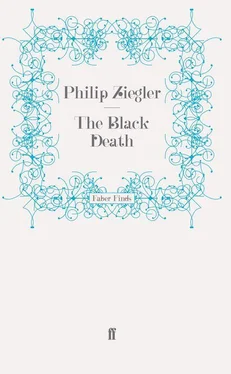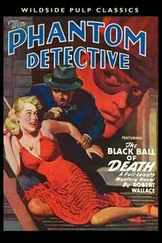The emphasis on this accusation is surprising. With the exception of the Faculty of Medicine at Paris, which suggested that a minor contributory cause of the epidemic might be the pollution of the wells as a result of earthquakes, none of the contemporary experts seem to have tried to link infection with the drinking of tainted water. There were other ways of spreading the plague which must have seemed at least as plausible to medieval man. Alfonso of Cordoba’s vision of the infection of air by the release of a ‘certain confection’ into a ‘strong, slow wind’ has already been mentioned {185} 185 34 p. 21 above.
and in subsequent epidemics Jews were accused of passing around clothes taken from the dead or smearing walls and windows with an ointment made from the buboes of plague victims.
A partial explanation may be that many wells in built-up areas were polluted by seepage from nearby sewage pits. The Jews, with their greater understanding of elementary hygiene, preferred to draw their drinking water from open streams, even though these might often be farther from their homes. Such a habit, barely noticed in normal times, would seem intensely suspicious in the event of plague. Why should the Jews shun the wells unless they knew them to be poisoned and how could they have such knowledge unless they had done the poisoning themselves? This theory is supported by Tschudi who, in the Helvetian Chronicle, records not only that the Jews knew the wells to be contaminated by ‘bad, noxious moistures and vapours’ but also that, in many places ‘they warned the people against them.’ {186} 186 35 cit Nohl, p. 252.
If they did, the warnings seem to have gone unheeded and certainly those who received them were little disposed to feel gratitude to the Jews for their consideration.
There can be little doubt that the majority of those who turned on the Jews believed in the literal truth of the accusations against them. It might be thought that this certainty would have been shaken by the fact that Jews died as fast as Christians; probably faster, indeed, in their crowded and unhealthy ghettoes. But the Christians seem simply to have closed their eyes to reality. Since the Jews caused the Black Death it was ridiculous to suppose that they could also suffer from it. Any appearance to the contrary was merely further evidence of their consummate cunning:
Judée la honnie
La maulvaise, la desloyal
Que bien net et aime tout mal
Qui tant donne d’or et d’argent
Et promis a crestienne gent
Que puis, rivières et fonteines
Qui estoient dares et seines
En pluseurs lieus empoissonèrent. {187} 187 36 Guillaume de Machaut Jugement du Roy de Navarre.
But though such crude suspicions might have been acceptable to the mob, they can hardly have been taken seriously by the intelligent and better educated. Dr Guerchberg has analysed the attitude of the leading plague tractators. {188} 188 37 S. Guerchberg, ‘La controverse sur les prétendus semeurs de la Peste Noire’, Revue des Études Juives, N.S., Tome VIII, 1948, pp. 3–40.
The most remarkable feature is how few references there are to the guilt or innocence of the Jews. Konrade of Megenberg brusquely dismissed the accusations: ‘Some say that this was brought about by the Jewish people, but this point of view is untenable.’ In his Buch der Natur he cites as evidence Jewish mortality in Vienna which was so high that a new cemetery had to be constructed. Gui de Chauliac was equally categoric. Alfonso of Cordoba considered that, by all the rules of planetary action, the Black Death should only have lasted a year and that any subsequent extension must be the result of a wicked plot. But he did not specifically accuse the Jews of being responsible. The ‘Five Strasbourg Physicians’ warned against poisoned food and water but it is doubtful whether they believed that the poisoning was done deliberately by man. {189} 189 38 E. Wickersheimer, ‘La Peste Noire à Strasbourg’, Proc. 3rd Int. Cong. Hist. Med., Antwerp, 1923, p. 54.
No other tractator paid any attention to the possibility that some human agency was involved in the spread of the plague, still less that such villains must be identified as the Jews.
On the whole this reticence on the part of the tractators must be taken to indicate that they did not believe the accusations. It is impossible that they did not know what had been suggested and, if they had really thought that a principal cause of the plague was the poisoning of the wells by Jews, then they could hardly have failed to say so in their examination of the subject. Their silence might imply that they thought the idea too ridiculous to mention but it is more likely that they shrank from expressing publicly an unpopular view on an issue over which people were dangerously disturbed.
For it took considerable moral courage to stand up for the Jews in 1348 and 1349 and not many people were prepared to take the risk. The first cases of persecution seem to have taken place in the South of France in the spring of 1348, and, in May, there was a massacre in Provence. Narbonne and Carcassone exterminated their communities with especial thoroughness. But it is possible that the madness might never have spread across Europe if it had not been for the trial at Chillon in September 1348 of Jews said to have poisoned certain wells at Neustadt and the disastrous confessions of guilt which torture tore from the accused. {190} 190 39 Text of confessions quoted by Hecker, op. cit., pp. 70–74.
Balavignus, a Jewish physician, was the first to be racked. ‘After much hesitation’, he confessed that the Rabbi Jacob of Toledo had sent him, by hand of a Jewish boy, a leather pouch filled with red and black powder and concealed in the mummy of an egg. This powder he was ordered, on pain of excommunication, to throw into the larger wells of Thonon. He did so, having previously warned his friends and relations not to drink the water. ‘He also declared that none of his community could exculpate themselves from this accusation, as the plot was communicated to all and all were guilty of the above charges.’ Odd scraps of ‘evidence’ were produced, such as a rag found in a well in which it was alleged that the powder, composed largely of ground-up portions of a basilisk, had been concealed. Ten similar confessions were racked from other unfortunates and the resulting dossier sent to neighbouring cities for their information and appropriate action.
So incriminating a confession settled the doubts or perhaps quietened the consciences of many who might otherwise have felt bound to protect the Jews. On 21 September 1348 the municipality of Zurich voted never to admit Jews to the city again. In Basle all the Jews were penned up in wooden buildings and burned alive. {191} 191 40 Matthew of Neueburg, op. cit., p. 262.
‘In the month of November began the persecution of the Jews,’ wrote a German chronicler. {192} 192 41 Heinricus de Diessenhoven, Fontes Rerum Germanicarum, Vol. IV, p. 68.
Henry of Diessenhoven has recorded the movement of the fever across his country. In November 1348 the Jews were burnt at Solothurn, Zofingen and Stuttgart; in December at Landsberg, Burren, Memmingen, Lindau; in January, Freiburg, Ulm and Speyer. At Speyer the bodies of the murdered were piled in great wine-casks and sent floating down the Rhine. In February it was the turn of the Jews at Gotha, Eisenach and Dresden; in March, Worms, Baden and Erfurt.
In most cities the massacres took place when the Black Death was already raging but in some places the mere news that the plague was approaching was enough to inflame the populace. On 14 February 1349, several weeks before the first cases of infection were reported, two thousand Jews were murdered in Strasbourg; the mob tore the clothes from the backs of the victims on their way to execution in the hope of finding gold concealed in the lining. In part at least because of the anti-Semitism of the Bishop, the Jews of Strasbourg seem to have suffered exceptionally harshly. A contemporary chronicle puts the grand total of the slaughter at sixteen thousand {193} 193 42 Michael Kleinlawel, Strassburgische Chronik., cit. Nohl, p. 242.
– half this would be more probable but the Jewish colony was one of the largest of Europe and the higher figure is not totally inconceivable.
Читать дальше












